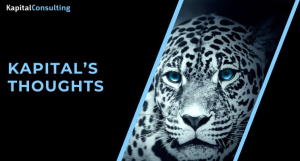Setting Up for Success: The Art of Onboarding New Starters
A great onboarding experience doesn’t start on day one. It starts before the laptop arrives, the logins are created, or the welcome coffee is booked.
Where the environment is fast-paced, the systems are complex and the people are time-poor, onboarding can often be treated as a tick-the-box exercise. But when done well, it’s one of the most powerful retention tools you have.
At Kapital, we’ve placed hundreds of professionals into BFSI firms across Australia. One thing we hear again and again? The onboarding experience sets the tone for everything that follows.
Here’s how to make sure your next hire feels confident, connected and ready to hit the ground running.
Prep Before Day One
Don’t wait until their start date to get things moving. A week before, send a warm welcome note with:
- What to expect on Day One (arrival time, location, dress code, who to ask for)
- Hardware delivery or desk setup (laptop, access cards, phone if required)
- Team structure or an org chart (so they can learn names/faces early)
- Any onboarding decks or business overviews (especially helpful in regulated or technical roles)
- A personal note from their hiring manager or a team member
- A welcome message or video call from the CEO or COO if possible (it makes a huge difference when new joiners hear from senior leadership early)
- Working with a recruiter? We’ll get this information from you prior to them starting, but it’s always a nice touch point to also receive a “looking forward to you joining”
If the exec team has a packed calendar, consider setting aside a designated monthly (or bi monthly) onboarding day – a short, focused session where all new joiners can meet senior leaders, hear about the company journey and ask questions.
Get the Basics Right
Few things frustrate new starters more than showing up and… nothing works.
Make sure this is sorted before they arrive:
- Laptop, email, Slack/Teams, Zoom access
- Security passes or remote access tokens
- Introductions booked with key stakeholders
- A clean desk if they’re coming onsite – with the right monitor/tech setup
- A plan for their first week (a light one is better than none at all)
Design a Proper First Week
A structured onboarding plan helps new hires absorb information at the right pace. Mix formal induction with informal intros:
- Day 1: Set expectations. Who do they report to? How often will you check in?
- Day 2-3: Meet with key cross-functional teams (don’t overload them, just prioritise the essentials).
- Day 4-5: Let them shadow meetings, review processes or explore systems. Give them a soft landing.
Even if they’re senior, don’t assume they’ll just “figure it out.” Internal culture, systems and expectations differ across every organisation.
Don’t Kill the Pace You Hired Them For
One of the biggest red flags we hear from new hires?
“I was brought in to bring energy, change and new ideas – then told to slow down.”
If you’ve hired someone to drive transformation or inject momentum, don’t stifle that energy on week one. If a manager’s first instinct is to say “that’s not how we work here” or “slow down”, that’s not feedback on the new hire – it’s a reflection of how the business has been operating.
Set the tone early: encourage contribution, curiosity and proactivity. New voices often see the clearest gaps. That’s what you hired them for.
Make Them Feel Connected Early
People remember how they felt in week one – not what systems they used.
Small things that go a long way:
- A welcome post on Teams or Slack, LinkedIn
- A buddy system
- Invitations to informal catch-ups or team stand-ups
- Add them to key email groups or channels so they’re in the loop
Remember Global Teams and Remote Joiners
If you’re hiring someone remotely or from a different region, don’t leave them out of the culture-building.
- Use video by default in week one – it builds rapport
- Schedule team-wide Zoom/Teams calls for intros and Q&A
- Send them a physical welcome kit if possible
- Pair them with someone local to help with time zone navigation and internal networks
First impressions matter even more when you’re onboarding remotely.
Set the Foundations for Retention
This isn’t just about onboarding. It’s about integration.
The number one reason we hear people leave roles early? “It just didn’t feel like the right fit.” That’s rarely about the job itself. It’s about how they were supported (or not) in the early days.
Check in after one week, one month and then regularly. Ask for honest feedback. Flag any road blocks early. The first 30-90 days are where you gain, or lose engagement.
You’ve invested time and money to hire the right person. Don’t let poor onboarding unravel that.
Thoughtful onboarding protects your investment, strengthens your culture and ensures new starters aren’t just “joining” – they’re contributing.
If you’d like a simple onboarding checklist to guide this process, let us know – we’re happy to share what’s working across the industry.
Because great onboarding isn’t just good for the candidate. It’s great for the business.
 Shannon Stobbs – Manager – LinkedIn
Shannon Stobbs – Manager – LinkedIn
Kapital Consulting is a niche Finance Technology Recruitment Business specialising in Technology, Project Services and Data Recruitment across Australia. For more information connect with us on www.kapitalconsulting.com.au and follow us on www.linkedin.com/company/kapital-consulting









